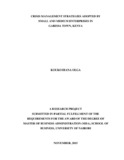| dc.description.abstract | As environmental turbulence increases, crisis emerge more frequently that challenge the way an organization formulates and implements its strategy. It is through crisis management strategy that a firm will be able to secure itself from threats brought about by the changes in the environment. But only big firms have embraced crisis management models leaving small business at a serious risk which in turn affects their turnover. The objective of the study was to establish the crisis management strategies adopted by SMEs in Garissa town, Kenya. Garissa town is known for harsh climatic conditions and rampant insecurity coupled with other diverse business threats yet there are SMEs there that have withstood the test of time. Therefore, it was necessary to find out how the SMEs in Garissa strategically manage crisis. The research adopted the diffusion of innovation theory by Ryan and Gross (1943). The design that was adopted is cross sectional descriptive survey because it focuses at one point in time. The study population was Small and Medium Enterprises based within the Garissa town in Garissa County. The number of Small and Medium Enterprises that were directly targeted in the study were 194. Primary data was collected using a structured questionnaire. The researcher then analyzed the data using SPSS. Frequency tables and means were used to present the findings. Descriptive analysis was conducted on primary data whereby mean and standard deviation were used as measures of central tendencies and dispersion respectively. The study also adopted one sample t-test. Out of 194 targeted respondents, 178 respondents filled-in and returned the questionnaires which made a response rate of 91.75 %. From the findings, the study found that most of the respondents were either certificate or diploma holders. This is an indication that majority of the respondents were literate and with a grasp of crisis management tips. The study revealed that the following crisis situations were very common: terror attacks, harsh weather conditions, financial crisis, competitor factor, inter-clan rivalry, robbery incidents, political instability, technological development, fire outbreaks and employee theft. The study further revealed that the most adopted crisis management strategies by the Small and medium enterprises in Garissa town were: one-off basis crisis management, proactive approach, re-active approach and adaptive decision making. The study recommends that SMEs should put in place crisis management strategic responses team or committee to help them gain detect, plan and manage any crisis. The researcher suggests that further research should be done on the challenges faced in adopting the crisis management strategies hence hindering their effectiveness in response to increased business threats. | en_US |

